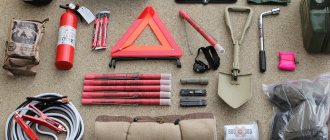Propane is most often called a mixture consisting of butane and propane. Impurities of other gases may be present, but they are insignificant. The peculiarity of propane is that it has neither odor nor color. This is quite dangerous, because it is difficult to establish and prevent the fact of a leak, which can lead to serious consequences. Therefore, an odorant substance, which has a pungent odor, is often added to the mixture. Propane is obtained during oil refining or during the extraction of petroleum gases. Propane is widely used in metallurgy and is also used as fuel. The mixture is transported in steel cylinders providing a pressure of 16 atmospheres.
- 2 Rules for safe handling of propane cylinders during transportation
- 3 Video: consequences of poorly secured gas cylinders
- 4 Video: how to safely disassemble a gas cylinder
- 5 How many cylinders can be transported?
- 6 Necessary documentation for transporting propane
General rules for transporting propane in cylinders
In order to avoid errors during transportation, the following conditions must be met:
- a vehicle transporting propane must be tested for the ability to transport dangerous goods, the vehicle must also be equipped with fire safety equipment and have signs on its sides warning about the transportation of explosive goods;
- care must be taken to draw up appropriate documentation permitting the transportation of propane in cylinders so that government authorities have the opportunity to verify compliance with the rules for the transportation of dangerous goods;
- Explosion warning stickers must be placed on the cylinders;
- the driver must be instructed in safety rules and be certified to transport propane cylinders.
Vehicle for transporting propane in cylinders
Propane cylinders intended for transportation should be stored in specially prepared places away from heaters, electrical wires and fire. When loading cylinders into a car in an open space, heating by the sun's rays should be avoided, so gas containers should be placed in the shade. Failure to comply with this rule can lead to tragedy. The minimum distance that can be between containers with propane and lubricants, oil and paint is 6 meters.
To avoid the possibility of falling, gas cylinders in the vehicle must be positioned horizontally. But in the case of propane, transportation in a vertical position without a container is allowed if gaskets are used between the cylinders and a special fence that protects against falling. Empty cylinders cannot be transported together with full ones.
What documents regulate the transportation of gas by road?
Today, gas transportation in Russia is regulated by several regulatory documents. First of all, this is Order of the Ministry of Transport No. 73 (08.09.95), which, according to experts, is already outdated, since it contradicts many modern requirements for cars and road conditions. The second standard is the Decree of the Government of the Russian Federation No. 272 (04/15/11), where clause 3 of the “General Provisions” section states that the transportation of dangerous goods in suburban, urban and international traffic must be carried out in accordance with Annexes A, B of the European Transport Agreement dangerous goods (ADR).
The main paradox is that Resolution No. 272 comes out of Federal Law No. 259, which applies to persons providing transport services, such as the transportation of gas cylinders. That is, if there is an agreement for the provision of such services, one should be guided by Decree No. 272, and in the absence of such an agreement (for example, it is necessary to transport a container from one warehouse to another with one’s own car) - by the old order No. 73. Although in its explanatory letters the Ministry of Transport emphasizes that in all situations ADR takes precedence and the movement of gas tanks should not contradict this agreement.
Transportation of dangerous cargo - gas - by Promtekhgaz company
As for drivers, they must attend a special course, pass an exam and receive a so-called ADR certificate, which is issued for five years and is valid in all countries that have signed the agreement. Such a certificate is a mandatory document for drivers of all vehicles transporting dangerous goods, including gas carriers. By the way, read about such transport in the article: gas carrier: design and operating rules.
Rules for safe handling of propane cylinders during transportation
Loading propane cylinders
Persons involved in loading may only handle cylinders with clean hands. To avoid the cylinder slipping, it is recommended to use clean gloves or a rag. This will prevent sand or grease from contaminating the valve nozzle. It is better to move cylinders from the warehouse to the car using carts designed for this purpose. Propane cylinders must not be dragged. When loading gas containers using lifting mechanisms, care should be taken to securely secure the cylinders to avoid falling.
In the case of propane transportation, negligence is punished especially severely! Here we are not talking about fines or banal loss of cargo, which entailed only financial losses. The consequences of ignoring safety rules can lead to a real emergency.
Transportation of gas cylinders by private individuals
The above regulatory requirements generally apply to legal entities - companies that transport gas-filled tanks. For private individuals, ADR makes an exception, according to which the provisions specified in this document do not apply if the transported gas containers are packaged for retail sale and are intended for personal consumption, household use, leisure and sports activities.
That is, a traffic police officer does not have the right to apply any sanctions to a private person transporting a gas cylinder in his car, which is intended for his own needs. However, the number and total volume of tanks are not regulated in any way. Claims can only be made if the conditions for the safe movement of such vessels are not met.
Many people transport gas cylinders in car trailers.
Video: consequences of poorly secured gas cylinders
When loading and unloading propane cylinders, the following rules should be followed:
- It is forbidden to work alone, at least 2 people can participate;
- You cannot carry cylinders on your arms or on your shoulder;
- cylinders should be loaded and unloaded in such a way that they do not hit each other or hit the ground;
- It is prohibited to hold and feed cylinders with the valve down;
- cylinders must have caps and plugs;
- it is necessary to protect the cylinders from rust and oxidation;
- during transportation, the cylinders must be secured to a rigid base;
- tightening the protective caps should be done by hand to avoid sparks;
- the temperature of the propane cylinder during transportation should not exceed 45 degrees Celsius;
- transporting propane and oxygen in the same car is strictly prohibited;
In order to disassemble a gas cylinder, you must also follow safety precautions. First, you need to make sure that the cylinder is empty. Then remove the protective caps and valve to fill the cylinder with approximately 30 liters of warm water. Only after this can the cylinder be cut to use it for your own purposes. Inventive citizens use a disassembled cylinder, for example, as a barbecue. Sometimes homemade heaters are made from it.
How to transport a gas stove
A gas stove, when all removable elements have been removed from it, is quite light, but you still need at least two people to take it out of the apartment and load it into the car. For transportation, you can use a truck or a car; a gas stove can easily fit in the trunk.
In a truck
In the case of transporting a slab in a truck, the main task is to securely fix the slab so that it does not slide along the body while the vehicle is moving.
Another point that you need to pay attention to is that the stove does not damage other transported items and boxes with sharp switches on/off the gas supply. Position the stove so that it cannot fall on other objects being transported, and these objects cannot fall on it, especially on the glass oven door.
note
In cargo transport, most often there are fastening straps that can be used to secure the slab so that it is not damaged during transportation.
In a car
The stove, unlike a washing machine , dishwasher and some other kitchen appliances, can be transported in any position, not just standing. Therefore, when transported in a passenger car, it can be placed lying on one of its sides to reduce the likelihood of it falling.
The gas stove fits perfectly into the trunk of almost any car. Place it lying down, and place several heavy boxes nearby so that it does not move around the trunk.
If you are transporting a stove in the cabin, for example, it can be placed behind the front passenger seat, press it firmly, but do not forget that it has sharp elements that can damage the upholstery of the car.
It would be a good idea to place unnecessary rags, a blanket, bed linen or something similar under the stove during transportation. Even if you have thoroughly washed the stove, it may remain sticky and may leak grease when shaken and other food residues may leak out of it. It’s better to play it safe than to order a full-scale dry cleaning of the interior later to remove the unpleasant odor and remove stains.
How many cylinders can be transported?
At the legislative level, the transportation of 15 propane cylinders in one vehicle does not apply to the transportation of dangerous goods. Propane has the smallest amount among other gases. The table shows comparative indicators of the maximum number of cylinders of different gases, at which the standards for the transportation of dangerous goods do not apply:
| Gas name | Group | Tara | Quantity |
| Argon | 2A | 40 liter cylinder | 24 pieces are allowed to be transported |
| Helium | 2A | 40 liter cylinder | 24 pieces are allowed to be transported |
| Carbon dioxide | 2A | cylinder weighing 24 kilograms and volume 40 liters | 41 pieces are allowed to be transported |
| Carbon dioxide | 2A | cylinder weighing 19 kilograms and volume 40 liters | 52 pieces are allowed to be transported |
| Nitrogen | 2A | 40 liter cylinder | up to 24 pieces inclusive |
| Oxygen | 2O | 40 liter cylinder | 24 pieces are allowed to be transported |
| Acetylene | 2F | A cylinder weighing 5 kilograms and volume 40 liters | 18 pieces are allowed to be transported |
| Propane | 2F | A cylinder weighing 21 kilograms and volume 50 liters | 15 pieces are allowed to be transported |
Class “A” includes neutral gases, “O” – oxidizing, “F” – flammable.
How many cylinders can you carry?
In general, transportation of 15 cylinders in one vehicle is not considered transportation of dangerous goods . And often you can carry significantly more without any problems! Below we provide a detailed rationale for this fact and provide a table of the maximum number of cylinders with the most common gases.
Regardless of what traffic police officers think about this, there is a LAW, and court decisions [, , ] confirm this.
The transportation of dangerous goods in the Russian Federation is regulated by the following documents:
[1] “Rules for the transportation of dangerous goods by road” (as amended by Orders of the Ministry of Transport of the Russian Federation dated June 11, 1999 No. 37, dated October 14, 1999 No. 77; registered with the Ministry of Justice of the Russian Federation on December 18, 1995, registration No. 997).
[2] “European Agreement on the International Carriage of Dangerous Goods by Road” (ADR), to which Russia officially joined on April 28, 1994 (RF Government Decree No. 76 dated 02/03/1994).
[3] “Road Rules” (Traffic Regulations 2006), namely Article 23.5, which establishes that “Transportation... of dangerous goods... is carried out in accordance with special rules.”
[4] “Code of the Russian Federation on Administrative Offences”, Article 12.21 Part 2 of which provides for liability for violation of the rules for the transportation of dangerous goods in the form of “an administrative fine for drivers in the amount of one to three times the minimum wage or deprivation of the right to drive vehicles for a period from one to three months; for officials responsible for transportation - from ten to twenty minimum wages.”
In accordance with clause 3 clause 1.2 [1] “The Rules do not apply to... transportation of a limited amount of dangerous substances on one vehicle, the transportation of which can be considered as the transportation of non-dangerous cargo.” It also explains that “The limited quantity of dangerous goods is determined in the requirements for the safe transportation of a specific type of dangerous goods. When determining it, it is possible to use the requirements of the European Agreement on the International Carriage of Dangerous Goods (ADR).”
Thus, the question of the maximum quantity of substances that can be transported as non-dangerous cargo comes down to the study of section 1.1.3 of ADR [2], which establishes exceptions from the European rules for the transport of dangerous goods associated with various circumstances.
So, for example, in accordance with paragraph 1.1.3.1 “The provisions of ADR do not apply ... to the transport of dangerous goods by private persons when these goods are packaged for retail sale and are intended for their personal consumption, household use, leisure or sport, provided that that measures have been taken to prevent any leakage of the contents under normal conditions of carriage."
However, a group of exemptions formally recognized by the rules for the transportation of dangerous goods are exemptions associated with quantities transported in one transport unit (clause 1.1.3.6 [2]).
All gases are classified into the second class of substances according to the ADR classification. Non-flammable, non-toxic gases (groups A - neutral and O - oxidizing) belong to the third transport category, with a maximum quantity limit of 1000 units. Highly flammable (group F) - to the second, with a maximum quantity limited to 333 units. By “unit” here we mean 1 liter of the capacity of the vessel containing the compressed gas, or 1 kg of liquefied or dissolved gas. Therefore, the maximum quantity of gases that can be transported in one transport unit as non-dangerous cargo is as follows:
| Gas | Class | Volume | Quantity |
| Nitrogen | 2A | 40 liter cylinder | up to 24 pieces inclusive |
| Argon | 2A | 40 liter cylinder | up to 24 pieces inclusive |
| Acetylene | 2F | 5kg/40l cylinder | up to 18 pieces inclusive |
| Helium | 2A | 40 liter cylinder | up to 24 pieces inclusive |
| Oxygen | 2O | 40 liter cylinder | up to 24 pieces inclusive |
| Propane | 2F | 21kg/50l cylinder | up to 15 pieces inclusive |
| Carbon dioxide | 2A | 24kg/40l cylinders | up to 41 pieces inclusive |
| Carbon dioxide | 2A | 19kg/40l cylinders | up to 52 pieces inclusive |
The most difficult situation is with acetylene. According to formal criteria (flammable gas, dissolved, 5 kg per 40 liter cylinder), one should consider 333/5 = 66 cylinders per transport unit. However, taking into account that the cylinder simultaneously contains 13.2 kg of equally flammable acetone, in which acetylene is actually dissolved, apparently, the maximum amount should be taken equal to 333/(5 + 13.2) = 18, which entered into the table.
Finally, in accordance with 1.1.3.6.4 ADR “If dangerous goods belonging to different transport categories are transported in the same transport unit, the sum of ... the number of substances and products of transport category “2” multiplied by 3, and the quantity of substances and products of transport category “3” should not exceed 1000″.
Example: Can 4 propane cylinders and 8 oxygen cylinders be transported together?
Calculation: (21[kg] * 4) * 3 + 40[l] * 8 = 572 < 1000. Therefore, such transportation will not be considered transportation of dangerous goods.
It is significant that clause 2.11.2 of the Rules for the Transportation of Dangerous Goods [1] states: “the combined transportation of different classes of dangerous goods on one vehicle (in one container) is permitted only within the limits of the rules of acceptable compatibility (presented in the table of Appendix 7.14).” The general meaning of the table is that the joint transportation of mutually reacting (for example, forming explosive mixtures) substances is not permitted. However, for some reason an exception was made for gases. Flammable gases (class 2.3 according to table 7.14 [1]), non-flammable non-toxic gases (class 2.1, which includes oxygen) and oxidizing substances (class 5.1) are compatible everywhere and are allowed for simultaneous transportation, while the carriage of oxidizing agents and flammable liquids (classes 3.1 and 3.2) is prohibited. Perhaps just by mistake? On the other hand, according to the same table, flammable liquids of class 3.3 with oxidizers can be transported... In any case, we strongly do not recommend transporting oxygen and propane together unless absolutely necessary, and especially if the car body is closed.
A.G. Blinov









